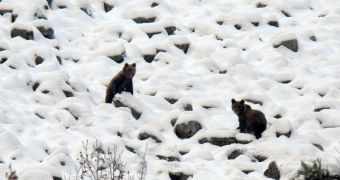A research carried out by Spanish scientists between 1998 and 2007, watching the brown bear population within the mountains of Cantabrian Cordillera and their hibernation habits, concluded that female bears with babies and independent young bears (under the age of 2) do not usually hibernate.
Apparently, the hibernation process has been questioned in several historical documents, who said that brown bears (Ursus arctos) do not always follow the hibernating pattern, all over the world.
The results of the study confirmed what King Alfonso XI wrote in 'Libro de la Montería', back in the 14th century, that female bears with young born during the previous year do not hibernate, or at least not all of them, unlike other bears that follow their winter sleep pattern.
The explanation given by King Alfonso XI was that the cubs were too annoying and they did not let the mothers sleep, and over 400 years later, the non-hibernating phenomenon was observed among two bear populations, in the east and in the west of the Cordillera Cantabrian mountain chain.
Scientists observed that the seven family groups in both bear populations did not stop eating of defecating over the period of observation, and as Carlos Nores, lead author of the study and a researcher at the Natural Resources and Zoning Institute (INDUROT) of the University of Oviedo (UNIOVI) and vice president of the Brown Bear Foundation, says, this means that “they did not enter the physiological state of hibernation at any time.”
He added that “during our monitoring of female bears with young, which we did in the east of the Cordillera Cantábrica on the basis of footprints and tracks, we saw that some animals stayed active throughout the whole winter.”
This lack of hibernation “has nothing to do with the harshness of the weather conditions, or snow levels being above or below average,” the scientists say.
They add that “bears may occasionally leave their caves during hibernation, but during true hibernation they do not eat, drink or defecate, although they may do so sporadically.”
Nores says that “the winter track count showed that female bears with young cubs aged between 11 and 14 months show signs of continuous activity, as do young bears of two years of age that are starting to become independent, although they do hibernate more than when they were in the family group.”
He points out that the other bears had “a significant reduction in activity between January and February, corresponding with predictable hibernation behavior.”
This study has been published in the journal Acta Theriologica, AlphaGalileo reports.

 14 DAY TRIAL //
14 DAY TRIAL //